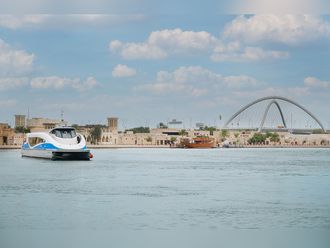A new book on Al Ain's Jebel Hafeet mountain reveals some of the most impressive and colourful caves ever discovered in the UAE.
Jebel Hafeet, A Natural History, sponsored by Abu Dhabi Company for Onshore Operations (ADCO), was recently published by Emirates Natural History Group (ENHG), Abu Dhabi.
The book, edited and compiled by Peter Hellyer, Chief Executive of Abu Dhabi Islands Archaeological Survey, and Simon Aspinall of ENHG, examines the entire structure and life of the only mountain of Abu Dhabi emirate.
It covers the geology, archaeology, and flora and fauna of the mountain, which is the most westerly outlier of the Hajar Mountain range. The mountain, south of Al Ain city, is shared by Oman and straddles the border between the two countries.
One of the chapters details the cave structures and their history as well as life inside.
The report on the caves was prepared by Tim Fogg, Pam Fogg and Tony Waltham, visiting British experts, following a survey they carried out in 1997.
According to them, stalagmite from one of the caves has been dated to 337,000 years ago, but the passages are much older and originate from either a water-past environment or a phase hydrothermal activity.
The cave with 450 metres of shafts, passages and chambers reaching to a depth of 96 metres is named Magharet Qasir Hafeet.
One of its chambers, the 15 metre long and 4 metre wide Crystal Ballroom, according to their report, is the finest chamber in the cave, with its walls liberally decorated with flowstone, stalagmite, stalactites, crystals and coralloid coatings.
"A long sloping climb up flowstone reaches the Red Room, smaller than the Ballroom, but with upper alcoves cut into ancient flowstone with spectacular red and white vertical banding.
"From a ledge in the far end of the Red Room, a narrow tube descends into fissures which double back beneath themselves into a vertical labyrinth of small rifts and tubes, mostly within a single fissure," the authors write in the report on Magharet Qasir Hafeet Cave System.
According to their study the largest and most mature passages are in the horizontal galleries near the entrance, and in the lower chambers of the Crystal Ballroom and the Red Room.
"The pattern may indicate that cave development was largely in two phases, the first when the water table stood at about the 1,050 metre level, and the second when it had been lowered to about the 1,000 metre level," the authors say.
The report also suggests that Magharet Qasir Hafeet was not formed at the top of a mountain.
It was formed by normal groundwater, and took place below the regional base level, with a very slow process. It also suggests the caves are one to sixteen million years old.
The report also details the creatures of the caves, which include insects and bats. Small fragments of vegetation, including grass stems and plant roots, were discovered in these caves during surveys in 1997 and 2000.
The chapter in the book also includes some poignant pictures of the caves. The report was first published in Tribulus, the biannual journal of ENHG, in 2002.
Other chapters in the book examine the archaeology and bird life on Jebel Hafeet.












